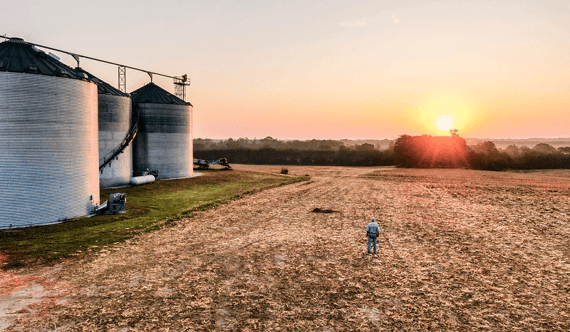
Farmers and other AgriBusiness stakeholders are increasingly recognizing the benefits of sustainable farming practices like cover cropping, reduced tillage, and diverse crop rotations. These and other sustainable farming practices can have many long-term benefits on the land, and promote resilient crops, but also have soil-building benefits that over time can reduce the chemical needs of the land.
The environmental impact of fertilizer use
Fertilizer use has a very high environmental impact. The production and transportation of synthetic fertilizers are energy-intensive processes and have a large environmental footprint. The costs associated with purchasing and applying large volumes of fertilizer can be a significant financial burden to farmers, and inefficient use can lead to economic losses.
Only a portion of the applied nitrogen is taken up by plants. Other portions are used by soil microbes, which produce the greenhouse gas N2O as a byproduct, lost to the water through leaching, and lost to the atmosphere through volatilization. When nitrogen is lost to runoff, high levels of nutrients like nitrogen and phosphorus can trigger algae blooms, which rapidly deplete oxygen levels when they decompose and can create aquatic dead zones. Improper fertilizer use can also contribute to soil degradation by disrupting nutrient cycling and reducing soil microbial diversity. This can lead to an imbalance in available nutrients and contribute to soil acidification, which can disrupt other natural biodiversity.
The importance of soil fertility
One of the remarkable ways sustainable farming practices benefit crop production is by supporting an improved soil structure that is better able to hold onto available nutrients and water. For instance, cover cropping provides vegetative cover throughout much of the year, which binds the topsoil in place to prevent loss of nutrients through erosion, and the roots and other biomass are incorporated into the soil as organic matter. Reduced tillage also directly increases organic matter when crop residue is incorporated into the soil. Organic matter is the glue that binds soil particles together, forming stable aggregates, and builds a porous soil structure with spaces for air and water.
This rebuilding of the soil with increased porosity has many benefits. Porous soil aggregates allow for improved aeration and the exchange of gasses like oxygen and carbon dioxide between the soil and the atmosphere. This promotes biological diversity and activity, because the steady supply of oxygen is essential for many soil microbes, and the aggregates themselves serve as microhabitats for microbes and provide access to organic matter as a food source. The porosity also directly improves the water- and nutrient-holding capacity, making the soil more resilient to fluctuations in weather and agricultural practices.
Organic matter acts as a natural nutrient reservoir in the soil. It has a high cation exchange capacity, which is the ability of soil particles to attract and retain positively charged ions, including ammonium nitrogen (NH4+). Ammonium is a form of nitrogen that is readily available to plants, and because of the strong charge, it is less prone to leaching. Organic matter also acts as a direct and slow-release source of nutrients, because as it decomposes, nutrients are gradually released into the soil.
Diverse crop rotations can also improve soil structure and fertility, as plants have different rooting depths, which delivers organic matter to different portions of the soil profile; and leguminous species can build soil fertility by fixing atmospheric nitrogen (N2) into plant-available nitrogen.
Innovations in fertility management
Many farmers and agronomists are familiar with the “4 R’s” of nutrient stewardship. This framework provides guidelines for optimizing nitrogen management and minimizing the environmental impacts of fertilizer use. The four principles include providing the right fertilizer source, at the right rate, at the right time, and in the right place. Matching these elements of fertilizer use can help ensure the nutrients match the crop requirements, to maximize yield and minimize nutrient losses.
Ceres Imaging offers innovative solutions in nutrient management that fit within the 4 R’s framework. When imagery is collected on bare soil fields prior to planting or emergence, zones identify areas of the field with similar soil properties, such as organic matter and cation exchange capacity. Management zones allow for targeted fertility management practices such as variable rate prescriptions for pre-season fertilizer. Adjusting the rate and placement of fertilizer using zones can be used to make significant reductions in overall fertilizer. Farming operations can also leverage the variability from bare soil flights to strategically prioritize fields to receive amendments or management practices.
Conclusion
Over time, sustainable farming practices like cover cropping, diverse crop rotations, and tillage can improve the soil structure and fertility. This transformation can reduce the amount of nitrogen fertilizer needed to achieve a high yield, which contributes to economic savings and environmental benefits. Leveraging imaging and analytics services from Ceres Imaging can further increase an operation’s sustainability. Management zones created from Ceres pre-season flights capture differences in soil properties like organic matter, which have different nutrient needs. Zone creation and variable rate tools allow the user to adjust the rate and placement of nitrogen fertilizer or other nutrients in the field. Growers can leverage these analytics to confidently reduce their overall nitrogen use, such as by adjusting their rates in high organic matter zones that have strong nutrient holding abilities, and in low organic matter zones that may be prone to leaching.
